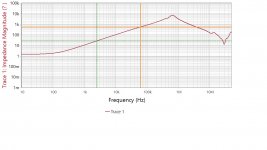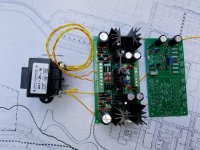So if I understand it correctly, I'd use it like this:
Xfrmr==>RingNot==>VoltRegModule==>MHPA.
Cheers,
Xfrmr==>RingNot==>VoltRegModule==>MHPA.
Cheers,
You don't need a regulator, and "ring-not" is only required if you observe a problem.
no necessity of gilding the Lilly
no necessity of gilding the Lilly
I think it is a good idea to try different PS topologies and methods and learn if/how the sound may be affected.
Personally, I prefer the shunt/push-pull type. Or other type which keeps both plus and neg at same voltage. Like master-slave. Or balanced push-pull. Or ground splitter.
Don't know if it will make an audible difference. Has anyone here tried different PS typologies and heard a difference? Maybe on an RIAA preamp?
I am now using just a series-pass type reg.
THx-Richard
Personally, I prefer the shunt/push-pull type. Or other type which keeps both plus and neg at same voltage. Like master-slave. Or balanced push-pull. Or ground splitter.
Don't know if it will make an audible difference. Has anyone here tried different PS typologies and heard a difference? Maybe on an RIAA preamp?
I am now using just a series-pass type reg.
THx-Richard
Last edited:
Jackinnj --- have you tried different PS with the HPA?
Others?
Is there one best PS topology over-all?
-Richard
Others?
Is there one best PS topology over-all?
-Richard
The reason why I ask is because I came across this:
That is worth fixing.
Pretty easy to see ringing -- if and when it exists. The most pernicious arises in switch-mode power supplies where di/dt is very vast.
With a torroid trafo and low cap diodes it doesn't appear to be a problem. With an EI core transformer that has high leakage inductance, and 1N4007's you can see the issue.
@richard -- I have used an SMPS brick, a linear brick and an unregulated linear supply with an Amveco trafo mounted in the case of a little salvaged HP amplifier. The linear brick is pretty small, salvaged from a piece of oil-field test equipment and the supply in current rotation.
I should look at the PSRR of the Marsh HPA.
Richard and jackinnj you guys have been at this longer than me.
The ring me not version of transformer/diode snubber is designed, built and tested for a particular transformer / diode combination. The Quasimodo will select a snubber for a wide range of transformer / diode combinations.
Morgan Jones wrote an article, for Linear Audio, that took a close look at PS transformer / diode ringing and concluded that snubbers to damp transformer / diode ringing are largely a solution looking for a problem, ringing is the exception not the rule. (My words here).
The snubber can add noise that otherwise would not be there.
Thanks DT
The ring me not version of transformer/diode snubber is designed, built and tested for a particular transformer / diode combination. The Quasimodo will select a snubber for a wide range of transformer / diode combinations.
Morgan Jones wrote an article, for Linear Audio, that took a close look at PS transformer / diode ringing and concluded that snubbers to damp transformer / diode ringing are largely a solution looking for a problem, ringing is the exception not the rule. (My words here).
The snubber can add noise that otherwise would not be there.
Thanks DT
Last edited:
@Richard, that is what I was thinking...can't hurt to try, and it is cost effective.
@Jackinnj, if ring then yes fix it. and, the ring not is cheap enough to try.
@kean, I'm not sure.
@DualTriode, do you recall which volume of Linear Audio? If solution w/o out problem, then it shouldn't hurt if I spec and built it correctly.
@everyman, because I am building two of these (one for me and one for my little girl) I could take diverging approaches, w/measurements and listening and report back.
Question, if I go with a higher output voltage transformer...say 15V or 20V, think those would be too much for theTL1963A, which has max input of 20V.
That said, what would be the next higher up or better voltage regulator for a standard type PSU?
I am still in the research and acquisition stage for the build.
Once I get everything and have a bench again, it shouldn't take long to do this.
The bench has proven to be more of a challenge than I thought--imagine that. and the projects keep rolling right in.
...and the beat goes on, ...and the beat goes on.
Cheers,
@Jackinnj, if ring then yes fix it. and, the ring not is cheap enough to try.
@kean, I'm not sure.
@DualTriode, do you recall which volume of Linear Audio? If solution w/o out problem, then it shouldn't hurt if I spec and built it correctly.
@everyman, because I am building two of these (one for me and one for my little girl) I could take diverging approaches, w/measurements and listening and report back.
Question, if I go with a higher output voltage transformer...say 15V or 20V, think those would be too much for theTL1963A, which has max input of 20V.
That said, what would be the next higher up or better voltage regulator for a standard type PSU?
I am still in the research and acquisition stage for the build.
Once I get everything and have a bench again, it shouldn't take long to do this.
The bench has proven to be more of a challenge than I thought--imagine that. and the projects keep rolling right in.
...and the beat goes on, ...and the beat goes on.
Cheers,
Last edited:
The article I wrote appeared in Linear Audio volume 10 (Sept 2015), pp.97-110. They charge €2,99 to download that one article from their website, or €19,90 plus shipping for the entire hardcopy volume, about 200 pages long.
Abstract
Power transformer secondary ringing was measured with 48 different semiconductor diodes; ringing amplitude was 10-20X lower with the best diodes than with the worst. They all rang, including Schottkys and HEXFREDs. A 1R + 2C snubber directly across the secondary completely eliminated ringing in every case.
Power transformer secondary ringing was measured with 48 different semiconductor diodes; ringing amplitude was 10-20X lower with the best diodes than with the worst. They all rang, including Schottkys and HEXFREDs. A 1R + 2C snubber directly across the secondary completely eliminated ringing in every case.
Thanks Mark,
Okay, now the only question are the values for the particular transformer. And, for a margin of safety...
I'm looking for the location in one of the threads about which measurement to use for the transformer and the resulting X or Lambds that equals 1.
Okay, now the only question are the values for the particular transformer. And, for a margin of safety...
I'm looking for the location in one of the threads about which measurement to use for the transformer and the resulting X or Lambds that equals 1.
Hello,
The Morgan Jones article is in Linear Audio Volume 5, April 2013.
I have a couple of Signal A41-25-16 power transformers on the shelf, rectified they will put out about 24VDC. I will use these power transformers with the AudioWind regulators linked in a previous post. I am skipping using the Quasimodo snubber/zobel and come back if there is an issue.
There is an impedance plot for the Signal A41-25-16 posted below.
Also on the shelf are a couple of Silent Switchers, they will do 150ma at +- 15 VDC, that will drive a single side of the Marsh HPA.
Thanks DT
The Morgan Jones article is in Linear Audio Volume 5, April 2013.
I have a couple of Signal A41-25-16 power transformers on the shelf, rectified they will put out about 24VDC. I will use these power transformers with the AudioWind regulators linked in a previous post. I am skipping using the Quasimodo snubber/zobel and come back if there is an issue.
There is an impedance plot for the Signal A41-25-16 posted below.
Also on the shelf are a couple of Silent Switchers, they will do 150ma at +- 15 VDC, that will drive a single side of the Marsh HPA.
Thanks DT
Attachments
Sync - Once you decide on a trafo, you might check the Quasimodo thread as there are data there with snubber values for various transformers. I also think there would be people with a Quasimodo who would make measurements for you if they have your transformer in their stock (aka junk box) - I would. Some of that data has been incorporated into a separate thread with a table of transformers and snubber values. My Marsh board is built but I'm assembling the Borbely shunt regulator from his preamp article in Linear Audio to compare against the Jung/Didden super regs from the diyAudio store. Good luck!
Phil
Phil
Most motherboards do 192KHz these days, I'll bet you could use one of these with a PC scope program:
Radio Shack Telephone Pickup W/suction cup-record Phone Calls 44-533 NEW 4029313097 | eBay
Radio Shack Telephone Pickup W/suction cup-record Phone Calls 44-533 NEW 4029313097 | eBay
That is going to be tough...it can only measure from 1Hz to 50MHz, how would someone address AM,FM, cell tower and other sources of interference?😀
Then I get to build a whole new circuit for an adjustable ducker. Mr. Ducker would probably be happy people are still using his snoop device and methodologies. Interesting that THAT Corp has schematics and chips to make it work. Tradecraft is a funny thing you must get beyond "usually, typically used to..."
Cheers,
Most motherboards do 192KHz these days, I'll bet you could use one of these with a PC scope program:
Radio Shack Telephone Pickup W/suction cup-record Phone Calls 44-533 NEW 4029313097 | eBay
Then I get to build a whole new circuit for an adjustable ducker. Mr. Ducker would probably be happy people are still using his snoop device and methodologies. Interesting that THAT Corp has schematics and chips to make it work. Tradecraft is a funny thing you must get beyond "usually, typically used to..."
Cheers,
Last edited:
I'm talking strictly about adjusting a snubber. If your secondary shorting cap is large enough it should shift the resonance frequency into the ultrasonic range or below. For 100nF I get 27uH for resonance at 96KHz. IIRC a more typical trafo leakage is 10 times that, so maybe somewhere in the 30KHz range. Of course it varies a lot with trafo type and secondary voltage.
So I looked on ebay to see what they had and price. Search word upper left, description center right. The good news was that eBay new is was a vector network analyzer. The other news is the babe eating zuckerpuppen (sugar puppets) comes with it. 🙂
Attachments
Last edited:
jackinnj,
Yes I did. The toy fund had a nice ROI.
It is interesting seeing all the peaks and dips in phase margin curves. Impedance is not so simple anymore.
DT
Yes I did. The toy fund had a nice ROI.
It is interesting seeing all the peaks and dips in phase margin curves. Impedance is not so simple anymore.
DT
- Home
- Amplifiers
- Headphone Systems
- Marsh headphone amp from Linear Audio


